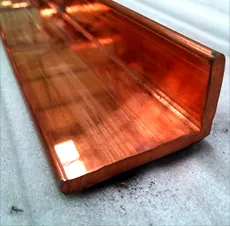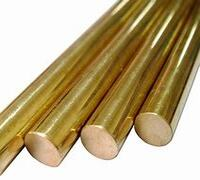1. Introduction
Just 24 hours ago, the London Metal Exchange reported a 3.2% surge in copper prices due to renewed global infrastructure investments—highlighting copper’s enduring value across industries. Among its many forms, the copper rod stands out as a foundational material in electrical, construction, and manufacturing sectors.

Whether you’re sourcing a copper earth rod for grounding systems or a copper brazing rod for metal joining, understanding the versatility and specifications of copper rods is essential. This guide breaks down everything you need to know—from types and uses to pricing and alternatives.
2. What Is a Copper Rod?
A copper rod is a solid cylindrical bar made from high-conductivity copper, typically produced through extrusion or drawing processes. Known for excellent thermal and electrical conductivity, corrosion resistance, and ductility, copper rods serve as raw stock for wires, connectors, and structural components.
Common variants include:
- Pure electrolytic tough pitch (ETP) copper rods
- Oxygen-free high-conductivity (OFHC) copper rods
- Alloyed rods like beryllium copper for specialized applications
These are often referred to interchangeably as rod copper or copper round bar, especially in industrial supply contexts.
3. Key Applications of Copper Rods
3.1 Electrical Earthing and Grounding
One of the most critical safety uses of copper rods is in earthing systems. A copper earth rod—also called an earthing rod copper or ground rod copper—is driven into the soil to safely dissipate electrical faults.
For cost efficiency without sacrificing performance, many engineers opt for copper bonded earthing rods. These consist of a steel core coated with a thick layer of copper (typically 0.25mm or more), offering the strength of steel and conductivity of copper.
Related terms include copper bonded ground rod, copper clad earth rod, and copper clad steel ground rod—all describing similar composite designs. The earthing rod price varies based on length, diameter, and copper thickness, with copper bonded options being more affordable than solid copper.
3.2 Welding and Brazing
Copper rods also play a vital role in metal joining. A copper brazing rod is used in high-temperature brazing processes, especially for joining dissimilar metals. For same-material joints, copper to copper brazing rods ensure strong, conductive bonds.

Similarly, copper welding rod or copper rod for welding is selected when working on electrical components or heat exchangers. Note that true ‘copper to copper welding rod’ applications often require inert gas shielding due to copper’s high thermal conductivity.
While less common than brazing, copper rod welding is feasible with proper technique and filler selection—often using phosphorus-deoxidized copper alloys.
4. Copper Rod vs. Related Products
4.1 Copper Strip and Flat Forms
Unlike round rods, copper strip (sometimes misspelled as copper stip or copper stripes) comes in flat, thin profiles—ideal for busbars, grounding straps, or decorative edging. You’ll see terms like flat copper strip, 1mm copper strip, or copper earth strip 25x3mm price when sourcing these.
Specialty variants include beryllium copper strip, nickel plated copper strip, and copper alloy strip—each tailored for specific conductivity, strength, or corrosion needs. Rolls of copper strip are popular for custom cutting, especially in electronics and renewable energy installations.
If you’re searching for ‘copper strip near me,’ note that many suppliers also offer stripping services for scrap recovery.
4.2 Copper Pipes and Tubing
While not rods, copper pipes share overlapping applications—especially in HVAC and plumbing. Air conditioning copper pipe (or aircon copper tube) is widely used due to its durability and thermal properties.
Sizes like 15mm copper pipe, 22mm copper tube, and 3/4 copper tubing are standard in residential systems. Pricing—such as ac copper pipe price or air conditioner copper pipe price—fluctuates with LME rates, much like copper rod price.
Unlike rods, pipes require soldering or compression fittings (e.g., SharkBite) for assembly, and proper bending and cleaning are crucial for leak-free performance.
5. Recycling and Scrap Considerations
With copper prices rising, stripping copper wire for scrap has become increasingly profitable. The best way to strip copper wire involves mechanical strippers—not burning, which releases toxic fumes and degrades metal quality.

Professionals use fast wire strippers or automated machines for stripping wire for recycling. Whether it’s thick cable or motor windings, clean, bare copper fetches top value.
Note: ‘Stripping copper wire for scrap’ is only worthwhile if done safely and legally—many recyclers reject burned or contaminated material.
6. Pricing and Sourcing Trends
Current copper rod price depends on purity, form (solid vs. bonded), and market volatility. Solid copper rods cost more than copper bonded steel alternatives but offer superior longevity in corrosive soils.
Similarly, copper strip price varies by thickness and alloy. A roll of copper strip may cost $20–$100+, while specialty items like copper tape for snails (used in garden pest control) are niche but available.
For bulk buyers, terms like copper bars for sale, cu bars, or flexible copper bus bar reflect broader product categories that include rods, flats, and ingots.
7. Conclusion
From safeguarding buildings with a copper earth rod to enabling precision joins with a copper to copper welding rod, the humble copper rod remains indispensable. Paired with complementary forms like copper strip and copper tubing, it supports everything from power grids to air conditioners.
As sustainability drives demand for recycled content, knowing the best way to strip copper wire—and understanding terms like copper clad steel earth rod or copper round bar—helps professionals make smarter, cost-effective choices in a dynamic market.
Our Website founded on October 17, 2012, is a high-tech enterprise committed to the research and development, production, processing, sales and technical services of ceramic relative materials such as What. Our products includes but not limited to Boron Carbide Ceramic Products, Boron Nitride Ceramic Products, Silicon Carbide Ceramic Products, Silicon Nitride Ceramic Products, Zirconium Dioxide Ceramic Products, etc. If you are interested, please feel free to contact us.

